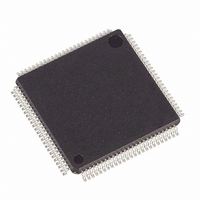DS21552L+ Maxim Integrated Products, DS21552L+ Datasheet - Page 90

DS21552L+
Manufacturer Part Number
DS21552L+
Description
IC TXRX T1 1-CHIP 5V 100-LQFP
Manufacturer
Maxim Integrated Products
Datasheet
1.DS21352L.pdf
(137 pages)
Specifications of DS21552L+
Function
Single-Chip Transceiver
Interface
E1, HDLC, J1, T1
Number Of Circuits
1
Voltage - Supply
4.75 V ~ 5.25 V
Current - Supply
75mA
Operating Temperature
0°C ~ 70°C
Mounting Type
Surface Mount
Package / Case
100-LQFP
Includes
DSX-1 and CSU Line Build-Out Generator, HDLC Controller, In-Band Loop Code Generator and Detector
Product
Framer
Number Of Transceivers
1
Data Rate
64 Kbps
Supply Voltage (max)
3.465 V
Supply Voltage (min)
3.135 V
Supply Current (max)
75 mA (Typ)
Maximum Operating Temperature
+ 70 C
Minimum Operating Temperature
0 C
Mounting Style
SMD/SMT
Ic Interface Type
Parallel, Serial
Supply Voltage Range
4.75V To 5.25V
Operating Temperature Range
0°C To +70°C
Digital Ic Case Style
LQFP
No. Of Pins
100
Filter Terminals
SMD
Rohs Compliant
Yes
Lead Free Status / RoHS Status
Lead free / RoHS Compliant
Power (watts)
-
Lead Free Status / Rohs Status
Lead free / RoHS Compliant
DS21352/DS21552
16.4 PROTECTED INTERFACES
In certain applications, such as connecting to the PSTN, it is required that the network interface be
protected from and resistant to certain electrical conditions. These conditions are divided into two
categories, surge and power line cross. A typical cause of surge is lightening strike. Power line cross
refers to accidental contact with high voltage power wiring. For protection against surges, additional
components and PCB layout considerations are required to reroute and dissipate this energy. In a surge
event, the network interface must not be damaged and continue to work after the event. In the event of a
power line contact, components such as fuses or PTCs that can “open” the circuit are required to prevent
the possibility of a fire caused by overheating the transformer. The circuit examples in this data sheet are
for “Secondary Over Voltage Protection” schemes for the line terminating equipment. Primary protection
is typically provided by the network service provide and is external to the equipment.
Figure 16-6 shows an example circuit for the 5 volt device and Figure 16-7 is an example for the 3.3
device. In both examples, fuses are used to provide protection against power line cross. 470 ohm input
resistors on the receive pair, a transient suppresser and a diode bridge on the transmit pair provide surge
protection. Resistors R1 – R4 provide surge protection for the fuse. Careful selection of the transformer
will allow the use of a fuse that requires no additional surge protection such as the circuit shown in Figure
16-7. The circuit shown in Figure 16-7 is required for 3.3 volt operation since additional resistance in the
transmit pair cannot be tolerated. For more information on line interface design, consult the T1 Line
Interface Design Criteria (note 353) and Secondary Over Voltage Protection (note 324) application notes.
These notes are available from Dallas Semiconductor’s web site.
90 of 137












